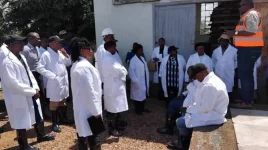Chegutu faces a significant water crisis as half the treated water escapes through leaks from aging pipes. This serious situation compounds existing shortages caused by Clifton Dam, reaching dangerously low levels at just 8 percent capacity. Town officials have begun implementing solutions to address these urgent problems and prevent further deterioration of water services to residents. The Chegutu Town Council has approached the national government requesting the acceleration of the Mhondoro B Dam project, which has experienced lengthy delays.
The municipality currently produces only eight megalitres daily despite requiring 16 megalitres to satisfy community needs. Current water reserves at Clifton Dam stand at merely 850 megalitres compared to its full capacity of 10,309 megalitres. Given these critically low reserves, officials express concern about maintaining an adequate supply throughout the coming year. The situation demands immediate attention as water security becomes increasingly precarious for local households.
According to Lovemore Mutsvangwa from the Town Council's business development office, a recent assessment involving key partners examined the entire water supply infrastructure. This evaluation identified major issues affecting raw water availability and distribution networks. Water demand projections indicate requirements will increase by 150 percent over two decades, reaching 40 megalitres daily. These estimates highlight the urgent necessity for substantial infrastructure improvements and better resource management practices.
Town Clerk Jacob Chikuruwo has noted plans for constructing over 10,000 new homes by 2026, further emphasizing the need for reliable water systems. The current loss of approximately 50 percent of treated water through network leakage means half the processed water never reaches consumers. Additional challenges include frequent electricity outages disrupting pumping operations, rapid population expansion exceeding infrastructure capacity, and geographic factors requiring continuous energy-intensive pumping.
Local authorities have identified both short-term and long-term strategies to prevent catastrophic shortages. The construction of the Mhondoro B Dam represents the most essential proposed solution, potentially providing sustainable water security for years ahead. Stakeholders recommend coordinated engagement with both the national government and Zimbabwe National Water Authority to expedite this crucial project. Comprehensive rehabilitation of deteriorating distribution networks must occur alongside increased treatment capacity to serve expanding urban development.
The municipality currently produces only eight megalitres daily despite requiring 16 megalitres to satisfy community needs. Current water reserves at Clifton Dam stand at merely 850 megalitres compared to its full capacity of 10,309 megalitres. Given these critically low reserves, officials express concern about maintaining an adequate supply throughout the coming year. The situation demands immediate attention as water security becomes increasingly precarious for local households.
According to Lovemore Mutsvangwa from the Town Council's business development office, a recent assessment involving key partners examined the entire water supply infrastructure. This evaluation identified major issues affecting raw water availability and distribution networks. Water demand projections indicate requirements will increase by 150 percent over two decades, reaching 40 megalitres daily. These estimates highlight the urgent necessity for substantial infrastructure improvements and better resource management practices.
Town Clerk Jacob Chikuruwo has noted plans for constructing over 10,000 new homes by 2026, further emphasizing the need for reliable water systems. The current loss of approximately 50 percent of treated water through network leakage means half the processed water never reaches consumers. Additional challenges include frequent electricity outages disrupting pumping operations, rapid population expansion exceeding infrastructure capacity, and geographic factors requiring continuous energy-intensive pumping.
Local authorities have identified both short-term and long-term strategies to prevent catastrophic shortages. The construction of the Mhondoro B Dam represents the most essential proposed solution, potentially providing sustainable water security for years ahead. Stakeholders recommend coordinated engagement with both the national government and Zimbabwe National Water Authority to expedite this crucial project. Comprehensive rehabilitation of deteriorating distribution networks must occur alongside increased treatment capacity to serve expanding urban development.












